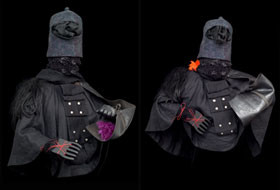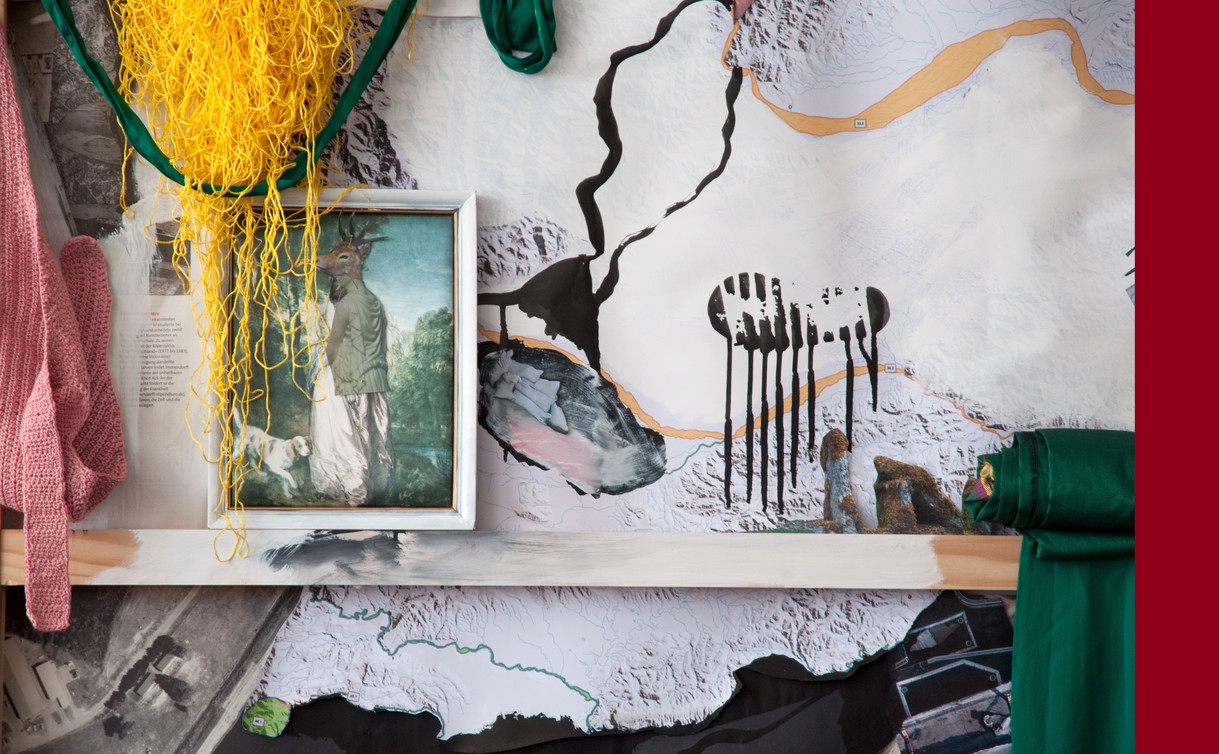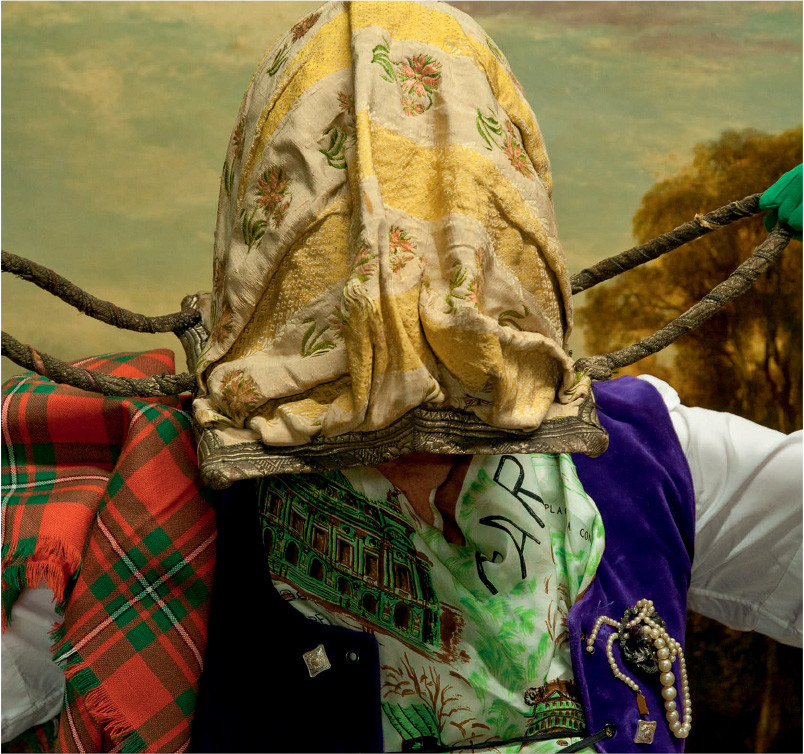A Space for Conversation
Chaos, collaboration and becoming in the works of Edwards + Johann
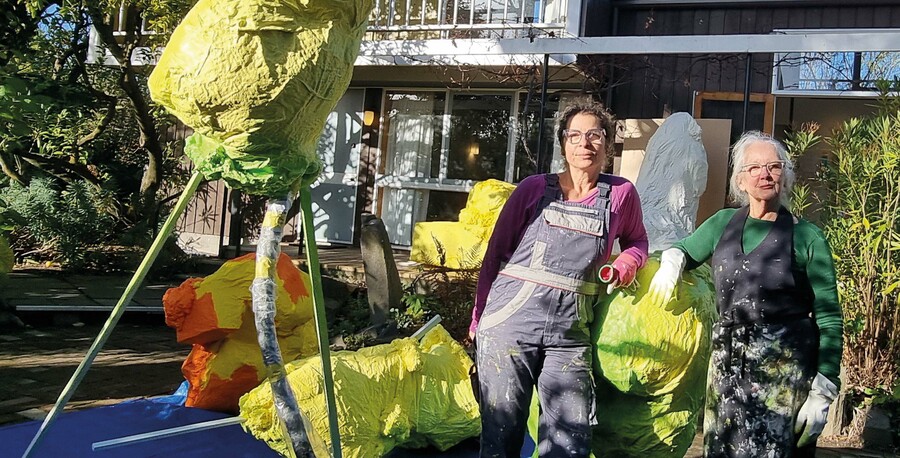
Ina Johann and Victoria Edwards (Edwards + Johann) at Sutton House, 2024
Ōtautahi Christchurch-based artists Victoria Edwards and Ina Johann have worked in artistic collaboration as Edwards + Johann since 2007. They take an interdisciplinary approach to art- making, combining photography, drawing, collage, performance, video and sculpture.
Curator Felicity Milburn spoke with the pair shortly after their month-long residency at Sutton House, during which they prepared sculptures for their upcoming Gallery exhibition. Edwards + Johann: Mutabilities—propositions to an unknown universe will combine these with other works made across the last five years to investigate ideas of response to place, connection and transformation. All of the works carry the indelible resonance of the unforgettable, and tragically unpredictable, geothermal environment of Whakaari White Island, which Edwards + Johann visited in 2018, prior to its devastating 2019 eruption.

Victoria Edwards working in the garden at Sutton House, 2024
FELICITY MILBURN: You’ve described your process as finding the work through making, rather than starting with a fixed idea. Can you describe how that has played out for this project?
EDWARDS + JOHANN: Our collaboration is about making work through the process of engaging—with each other and with our lived experiences. And residencies have played a significant role in our growth over the years. This new body of work has developed out of our Volcanic Artist Residency in Whakatāne, which included two visits to Whakaari White Island. So there’s the lived experience and then there’s the moment—the ‘where we are’ at the time, which in this case is Sutton House. A beautiful big studio, one month and the ‘what if’ factor. For us this offered a portal of potentiality, and of course we were excited to engage.
Sutton House also gave us the space to play with scale— how big is too big? It was a testing ground to draw out kernels from some of our two-dimensional work and play them out in three dimensions. Our aspirational idea was to build an environment of objects that enriched, interacted with, and engaged with, the existing two-dimensional works in the exhibition to create tensions and contradictions through the use of colour, form, scale and proportion.
We accepted our physical limitations and wanted to be able to pivot in process when appropriate. So we engaged in a low tech way, using humble materials with a hands-on approach. It is important for us to be close to the process as it allows us to tease out and nurture content and create meaning as the works progress. Our collaborative way of working has conversational opportunities built in. These are around the practicalities—how the process develops as work evolves—and also broader discussions about what the work is revealing and becoming. We never want to forget that all materials have a voice; as artists we think we can manipulate them astutely and adeptly, and often we can, but at other times they have a life of their own and a will that we need to honour and listen to. They won’t simply do what we want of them, but they will suggest new possibilities, new directions, and we can either follow along with those or not. This is an important part of the ‘becoming’ of the works for us. Of course, we had an idea of what the finished exhibition would include: a mood, a meaning if you will, but it’s important to us to retain a fluidity, flexibility and a spontaneity in the process. It is in this coming together that they reveal themselves—where the research meets the making and from there the content unfolds.
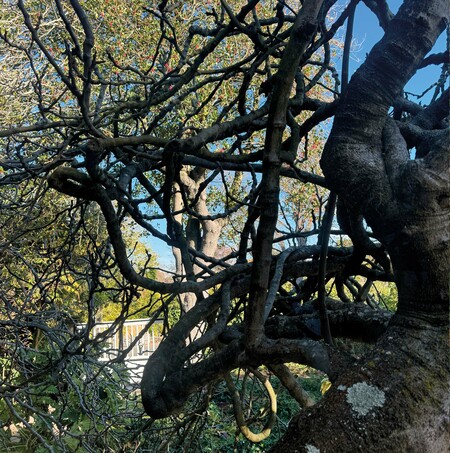
The fig tree at Sutton House, 2024
What did it mean to you to be working at Sutton House? How did that environment affect the work?
The place where you are always influences you, but Sutton House was particularly wonderful because we both really enjoyed the view, the garden, the light, the trees—that fig tree is just so beautiful! There are always many layers to an unknown space or place. We enjoy the perusal and the uncovering, the hidden folds and the threads that open up when you spend time in a place that you are unfamiliar with.
The opportunities we had here—supported by the Gallery, the use of this fantastic big studio—meant that we knew we had the freedom to run with our ideas. We could play and go with whatever happened in the space. That was pretty exciting. There’s such a beautiful winter light in the Red Zone and it enters the studio from all directions. We loved that we could open the doors and take the works outside, or use the courtyard to isolate a work so that we could stand back and look at it critically together.
Timewise, the project has been bigger than we imagined (another four weeks would have been great). Living on the property allowed us to work from morning till night, uninterrupted and unencumbered by the demands of our ordinary lives. The Red Zone location offers a unique oasis of peace and tranquillity that is home to some beautiful native trees, and yet still relatively central to Ōtautahi.
The fig tree outside the studio window felt like it was always watching us. Spotlit at night and enjoyed by the birds all day, it has a special and unique presence. In the last few days of our residency we realised we had developed some small affection for that tree. Its sensibility had permeated our perception and production in various tangible and intangible ways. Each residency so far has surprised us by offering loose threads of curiosity that beg to be followed. We intend to return to the garden to make fig tree drawings at a later date.
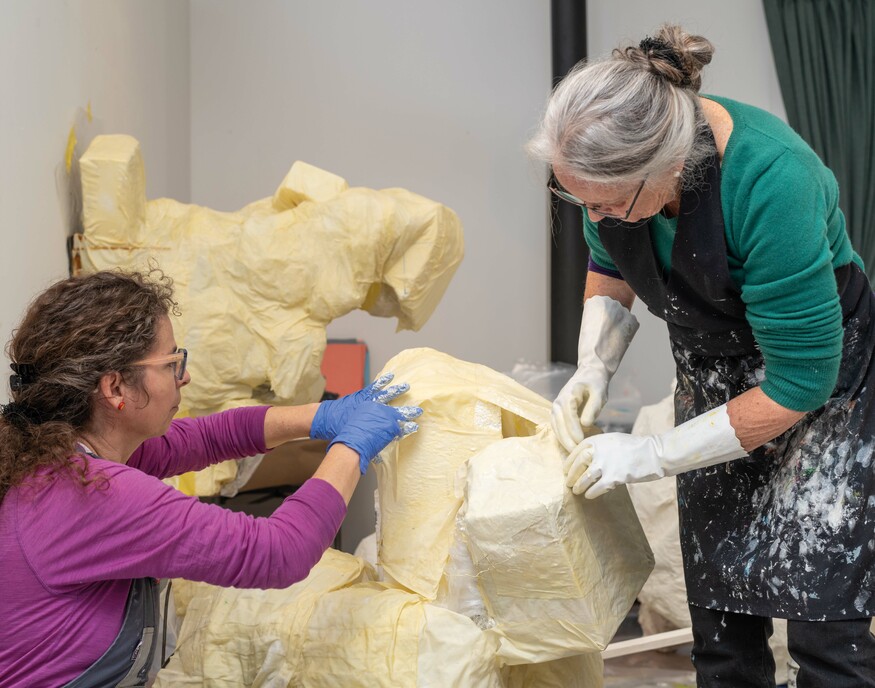
Ina Johann and Victoria Edwards (Edwards + Johann) at Sutton House, 2024
Have all the residencies you’ve done had an exhibition of some kind at the end?
Sometimes yes, sometimes no. Sometimes opportunities formed while we were there—our hosts were open to it, but they weren’t putting pressure on us, it was something that could be decided. After spending two weeks setting up our survey show from THE EDGE of SPACES in Whakatāne in 2018,1 Whakatāne Library and Exhibition Centre offered us their window space for a first research-based installation. They also took us to Whakaari White Island. We only had two weeks in Whakatāne on that trip, but we had already done a lot of research and made a lot of small objects in preparation, so we were able to set up a display in the museum. We were offered another exhibition of new work after the completion of the main part of the Volcanic Artist Residency.
When we were first in Scotland as the International Artists in Residence for the Perth 800 celebrations we used our time to research and explore the area.2 We made a lot of collages, drawings and video recordings, and also spent quite a lot of time in the Perth Museum and Art Gallery’s collection. The opportunity to access and research that collection was a wonderful experience for us. The main works that resulted from that residency were showcased later on our return visit. We did a workshop with students and exhibited as part of the Perth 800 celebrations.
It always depends on the nature of the residency and the set up. Each residency offered us a different framework and opportunities. For the Château de Padies Artist in Residence Programme in Lempaut, France,3 we weren’t expected to present work at the time, but we were happy to do so. At the end of the residency they had an open day at the château and we were invited to perform alongside poets, other artists and musicians. We did a costumed performance in the garden and developed an installation in the attic. On returning the following year, we presented a new exhibition and performance.
How we approach those kinds of situations depends on a whole range of factors. It’s about navigating and negotiating with people, equipment, situations, available funding— seeing what’s possible when you get there. For us, one of the richest residencies was at the Altes Spital in Switzerland, because we had three months there and we were able to explore the place in depth. We were given a lot of freedom and also a lot of support from the institution. We had a train ticket that meant it was free to go anywhere around Switzerland to see art and discuss what we had seen. But residencies are always beneficial—they mean growth to an artist, whether they are tailored to help you realise a work, or feed into your research, or fill up your bucket of curiosity and wonder so that you can actually go out and explore the world in another way again.
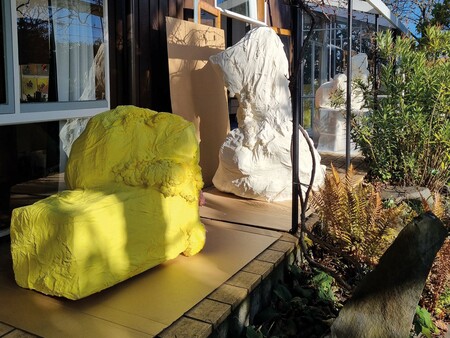
Work in progress in the garden at Sutton House, 2024
The ever-changing landscape on Whakaari clearly has special resonance for you after having been through all the adaptations of the earthquake years here. What sorts of ideas have been at the forefront of your minds as you make this new work?
There’s a lot of chaos in the world. Things are constantly evolving, being there and not there, growing and decaying. You could label a lot of the natural processes that we observe as chaotic. We are part of that chaos and, in a way, trying to make sense of it all the time. In the ‘becoming’ of these abstract objects we have contemplated aspects of a biomorphic character, suggestive of something living but not a plant—a leg, or a specific organism. Elements that suggest simple acts of survival and adaptation.
Was that tree trying to tell us something of resilience, flexibility, guardianship, radical acceptance, the seasons of life? The works are a family or group, an odd bunch. They are like characters from Waiting for Godot queueing up in their best clothes with their various stances and expressions; actors in the wings, ready to perform their parts.
While we worked, we listened to the audiobook The Hidden Life of Trees by Peter Wohlleben, and grew fond of his phrase “slightly more active than rocks”. The new forms embrace imperfection and slippages. With their human proportions they embody our relationship to forces in nature. They offer another piece in what we think of as the puzzle narrative of our collaborative practice. As artists, we are humorous and playfully ambiguous, committed to the importance of physically creating our work but drawn to the complex and illusive.
The relative isolation of the residency, as we chose to play it out, allowed us to reflect on the complex, cyclic narrative of our practice and the bodies of work we have produced since 2007. Our performative costume-clad bodies engaging in a predetermined three-dimensional space whilst being filmed is a form of sculpture for us. A lot of objects we develop feel animated like characters; sometimes unfaltering, sometimes whimsical. Bill Sutton said in 1974, “All the shapes I wish to use are about me in our natural environment”. In response, we say “this new work made at Sutton House includes all the shapes we wish to make”.









